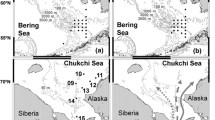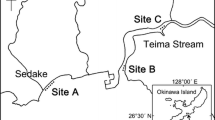Summary
Larvae of Euphausia superba in the Atlantic sector of the Antarctic in March 1984 averaged 580 per 1000 m3 of water. This is 100 times less than we observed in March 1981, but more than the average of 250 larvae per 1000 m3 found in January–February 1981. There was one 1984 high-abundance sample, accounting for 85% of all larvae caught, from the eastern area of confluence of Drake Passage and Weddell Sea waters. Abundances in 1984 near the South Shetland Islands were commonly 5 to 10 larvae per 1000 m3, and younger by 2 to 4 developmental stages than in March 1981. Body lengths of given stages were generally less in 1984 than in 1981. Advanced furcilia stages, particularly, in the 1984 samples tended to be smaller than the same stages in March 1981, indicating relatively poor growth during February 1984. However, the 1984 younger larvae (calyptopes and the developmental forms of furcilia stages 1 and 2) indicated that, in 1984, recent (March) growth had been good — probably better than in February. Dierct observation of the development of calyptopis stage 3 to furcilia stage yielded a development time of 7.7 days, which compares favorably to the 8-day period estimated from field samples. Reduced food availability did not affect the development rate nor give rise to a clearly higher incidence of indirect pathways of development. It is postulated that recruitment was about of month later in 1984 than in 1981 in most of the area studied and was probably going to be less successful.
Similar content being viewed by others
References
Brinton E (1984) Observations of plankton organisms obtained by bongo nets during the November–December 1983 Ice-Edge investigations. Antarct J US 4:113–115
Brinton E (1985) The oceanographic structure of the eastern Scotia Sea. 3. Distributions of euphausiid species and their developmental stages in relation to hydrography in 1981. Deep-Sea Res
Brinton E, Antezana T (1984) Structures of swarming and dispersed populations of Krill (Euphausia superba) in Scotia Sea and South Shetland waters during January–March 1981, determined by bongo nets. J Crust Biol 4:45–66
Brinton E, Townsend AW (1984) Regional relationships between development and growth in larvae of Antarctic krill, Euphausia superba, from field samples, J Crust Biol 4:224–246
Fevolden SE (1980) Krill off Bouvetöya and in the southern Weddell Sea with a description of larval stages of Euphausia crystallorophias. Sarsia 65:149–162
Fevolden SE, George RY (1984) Size frequency pattern of Euphausia superba in the Antarctic peninsula waters in the austral summer of 1983. J Crust Biol 4:107–122
Foster TD, Middleton JH (1984) The oceanographic structure of the eastern Scotia Sea. 1. Physical oceanography. Deep-Sea Res 31:529–550
Fraser FC (1936) On the development and distribution of the young stages of krill (Euphausia superba). Discovery Rep 14:1–192
George RY (1984) Ontogenetic adaptations in growth and respiration of Euphausia superba in relation to temperature and pressure. J Crust Biol 4:252–262
George RY, Strömberg J-O (1985) Development of eggs of antarctic krill Euphausia superba in relation to pressure. Polar Biol 4:125–133
Hempel I (1981) Euphausiid larvae in the Scotia Sea and adjacent waters in summer 1977/78. Meeresforsch 29:53–59
Hempel I (1985a) Variation in geographical distribution and abundance of larvae of antarctic krill, Euphausia superba in the southern Atlantic Ocean. In: Siegfried WR, Condy PR, Laws RM (eds) Antarctic nutrient cycles and food webs. Springer, Berlin Heidelberg, pp 304–307
Hempel I (1985b) Vertical distribution of larvae of antarctic krill, Euphausia superba. In: Siegfried WR, Condy PR, Laws RM (eds) Antarctic nutrient cycles and food webs. Springer, Berlin Heidelberg, pp 308–310
Hempel I, Hempel G (1978) Larval krill (Euphausia superba) in the plankton and neuston net samples of the German Antarctic expedition 1975/76. Meeresforsch 26:206–216
Hempel I, Hempel G, Baker AC de (1979) Early life history stages of krill (Euphausia superba) in Bransfield Strait and Weddell Sea. Meeresforsch 27:267–281
Huntley ME, Barthel KG, Star JL (1983) Particle rejection by Calanus pacificus: discrimination between similarly sized particles. Mar Biol 74:151–160
Huntley M, Marin V, Sykes P, Rohan S (1984) Antarctic salps. 2. Trophodynamics. EOS, Trans Am Geophys Un 65:922
Ikeda T (1984) Development of the larvae of the Antarctic krill (Euphausia superba Dana) observed in the laboratory. J Exp Mar Biol Ecol 75:107–117
Ikeda T, Dixon P (1982) Body shrinkage as a possible over-wintering mechanism of the antarctic krill, Euphausia superba Dana. J Exp Mar Biol Ecol 62:143–151
Jackowska H (1980) Krill monitoring in Admiralty Bay (King George Island, South Shetland Islands) in summer 1979/1980. Polish Polar Res 1:117–125
Jazdzewski K, Dzik J, Porebski J, Rakusa-Suszczewski S, Witek Z, Wolnomiejiski N (1978) Biological and populational studies on krill near South Shetland Islands, Scotia Sea and South Georgia in the summer 1976. Pol Arch Hydrobiol 25:607–631
Kikuno T (1981) Spawning behavior and early development of the Antarctic krill, Euphausia superba Dana, observed on board RV Kaiyo Maru in 1979/80. Antarct Rec, Tokyo 73:97–102
Kittel W, Jazdzewski K (1982) Studies on the larval stages of Euphausia superba Dana (Crustacea, Euphausiacea) in the southern Drake Passage and in the Bransfield Strait in February and March 1981 during the BIOMASS-FIBEX expedition. Polish Polar Res 3:273–280
Knight MD (1984) Variation in larval morphogenesis within the Southern California Bight population of Euphausia pacifica from winter through summer, 1977–1978. Calif Coop Oceanic Fish Invest Rep 25:87–99
Lipski M (1982) The distribution of chlorophyll-a in relation to the water masses in the southern Drake Passage and Bransfield Strait (BIOMASS-FIBEX, February-March 1981). Polish Polar Res 3:143–152
Mackintosh NA (1972) Life cycle of Antarctic krill in relation to ice and water conditions. Discovery Rep 36:1–94
Makarov RR (1972) The life history and peculiarities of the distribution of Euphausia superba Dana. Tr Vses Nauchno-Issled Rybnogo Okeanogr 77:85–92
Makarov RR (1974) Larvae of Euphausia superba Dana in plankton from the Sea of Scotia. Tr Vses Nauchno-Issled Rybnogo Okeanogr 99:84–103
Makarov RR, Maslennikov VV (1981) Ecology of larval development of the crustacean Euphausia superba. Change in dominant larval forms as a function of environmental conditions. Mar Ecol Prog Ser 4:265–271
Marin V, Huntley M, Sykes P, Rohan S (1984) Antarctic salps. 1. Biomass, distribution and biometry. EOS, Trans Am Geophys Un 65:922
Marr JWS (1962) The natural history and geography of the Antarctic krill (Euphausia superba Dana). Discovery Rep 32:33–464
Marschall H-P (1983) Sinking speed, density and size of euphausiid eggs. Meeresforsch 30:1–9
Marschall H-P (1984) Development, swimming and feeding of early stages of krill. Antarct J US 19:137–138
Marschall H-P, Hirche H-J (1984) Development of eggs and nauplii of Euphausia superba. Polar Biol 2:245–250
Marschall S, Mizdalski E (1985) Euphausiid larvae in plankton samples from the vicinity of the Antarctic Peninsula, February 1982. Beri Polarforsch 21:1–47
McWhinnie MA, Denys CJ (1978) Biological studies of antarctic krill, austral summer, 1977–1978. Antarct J US 13:133–134
Miller C, Huntley M, Brooks E (1984) Post-collection molting rates of planktonic, marine copepods: measurement, applications, problems. Limnol Oceanogr 29:1274–1289
Nast F (1979) The vertical distribution of larval and adult krill (Euphausia superba Dana) on a time station south of Elephant Island, South Shetlands. Meeresforsch 27:103–118
Quetin LB, Ross RM (1984a) School composition of the antarctic krill Euphausia superba in the waters west of the antarctic peninsula in the austral summer of 1982. J Crust Biol 4:96–106
Quetin LB, Ross RM (1984b) Depth distribution of develo** Euphausia superba embryos, predicted from sinking rates. Mar Biol 79:47–53
Rakusa-Suszczewski S (1984) Krill larvae in the Atlantic sector of the Southern Ocean during FIBEX 1981. Polar Biol 3:141–147
Rakusa-Suszczewski S, Stepnik R (1980) Three species of krill from Admiralty Bay (King George, South Shetlands), in summer 1978/79. Pol Arch Hydrobiol 27:273–284
Reeve MR (1981) Large cod-end reservoirs as an aid to the live collection of delicate zooplankton. Limnol Oceanogr 26:577–579
Ross RM, Quetin LB (1982) Euphausia superba: fecundity and physiological ecology of its eggs and larvae. Antarct J US 17:166–167
Stein M, Rakusa-Suszczewski S (1984) Meso-scale structure of water masses and bottom topography as the basis for krill distribution in the South Eastern Bransfield Strait, February-March 1981. Meeresforsch 30:73–81
Strickland JDH, Parsons TR (1972) A practical handbook of seawater analysis, 2nd edn. Bull Fish Res Board Can 167:1–310
Uribe E (1982) Influence of the phytoplankton and primary production of the Antarctic waters in relationship with the distribution and behavior of krill. Inst Antarct Chileno, Sci Ser 28:147–163
Witek Z, Koronkiewicz A, Soszka GJ (1980) Certain aspects of the early life history of krill Euphausia superba Dana (Crustacea). Pol Polar Res 1:97–115
Author information
Authors and Affiliations
Rights and permissions
About this article
Cite this article
Brinton, E., Huntley, M. & Townsend, A.W. Larvae of Euphausia superba in the Scotia Sea and Bransfield Strait in March 1984 — Development and abundance compared with 1981 larvae. Polar Biol 5, 221–234 (1986). https://doi.org/10.1007/BF00446090
Received:
Accepted:
Issue Date:
DOI: https://doi.org/10.1007/BF00446090




